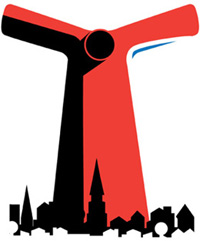We seek recognition of the problems created for downtown Charleston by the recent tripling of cruise ship visits, by the increasing size of these ships, and by new Carnival cruises that require passengers to drive or be driven downtown to embark and debark.
The obvious problems from a year of such visits include congestion from increased traffic and street closures, air pollution from dirty fuels used to power these large ships in port that soil neighboring buildings and endanger health, noise from ship horns and PA systems and visual degradation of the Holy City’s Colonial-era skyline of steeples and historic buildings.
We seek a solution that substantially solves these problems and will, in addition protect all jobs and economic benefits from cruise operations, guarantee new job creation and generate significant economic development in Charleston.
1. Make “Voluntary Limits” Recommended by SPA and City Legally Binding.
In recognition that an already congested downtown is stressed by cruise operations, the SPA and the City have offered “voluntary limits” of a maximum of 104 ships visits a year, no ships larger than 3,500 passengers (mega-ships), no more than one ship at a time, and no discharges within 12 miles of shore. We join affected neighborhoods and other organizations who seek to make these limits on cruise operations binding and enforceable, so that in the future the SPA will not be compelled to maximize revenue in the form of passenger and parking fees at any proposed expanded cruise terminal capacity. No business in Charleston is permitted to operate unregulated, on a nonbinding agreement, and the giant, worldwide cruise ship industry must not be the first.
2. All possible sites for a new cruise terminal should be studied, considering both positive and negative impacts, so the best option for Charleston is selected.
Problems with traffic congestion and visual blight would be addressed by placing the new cruise terminal at available space at the northern end of the Columbus Street Terminal near the Ravenel Bridge. Traffic would leave city streets on Morrison Drive before East Bay Street and large, modern ships would be framed against the beautiful Ravenel bridge rather than the small-scale historic downtown skyline.
Air pollution and noise would be mitigated for most east side residents, and mandatory on-shore power and strict enforcement of noise ordinances would eliminate these problems.
Union Pier could then be used for its highest and best use a mixed-use development (expansion of the riverfront public park, residences, shops, restaurants, offices, and other amenities) and allow unlimited public access to the entire Cooper River waterfront and reopened streets.
KEY POINTS IN SUPPORT OF C4 SOLUTIONS:
- Modern cruise terminals are not located next to residential areas, particularly
historic areas. For example, Boston’s redeveloped terminal is three miles from thecenter of that historic city. - The SPA did not allow its consultants to consider any alternative sites for the location of the passenger terminal, instead only looking at Union Pier, in the heart of the city’s national historic district.
- Cruise operations at Union Pier jeopardize the quality of life, health and property values of nearby residents and businesses by traffic congestion, pollution, soot, noise and visual impairment to our historic skyline and city. Such operations jeopardize traditional land-based tourism drawn by historical ambiance, as confirmed by the National Trust for Historic Preservation, which took the unprecedented step of placing Charleston on a specifically created “Watch List” of newly endangered historic places. The Historic Charleston Foundation recognized these problems and proposed an ordinance which should be adopted by the City. The Preservation Society of Charleston and neighborhood and environmental groups have recognized these threats and filed a lawsuit to stop such activities.
- The present Union Pier site is unsightly: dilapidated buildings surrounded by cyclone fencing and razor wire. It is in the middle of a residential/commercial area, but its use is, and otherwise will continue to be, substandard for the most valuable waterfront property in South Carolina.
- Carnival has a tarnished record of environmental compliance. The company pays no local taxes or fees despite its negative impact on our roads, air, skyline, waters and quality of life, even though its annual profits are in the billions. Positive economic benefits flow mostly to the SPA and Carnival, and the negative effects on the downtown economy, property values, and quality of life far outweigh any incidental benefits to the local economy.
- Using another site for a cruise terminal would allow the redevelopment of the entire 65 acre Union Pier site for mixed-use development (shops, restaurants, offices, parks and residences) that would provide maximum long-term job creation, millions in future tax revenue, and complete public waterfront access that the current SPA plan fails to provide.
- The Union Pier site should be sold to private developers for the “highest and best” use, thus creating a significant cash windfall for the state. Union Pier development, supervised by the City and BAR, with small-scale streets and waterfront access for all would add millions in annual revenues and create
hundreds of permanent jobs. The State has the power to compel disposition of SPA property for private redevelopment as it did in 2009 when it passed a law
ordering the SPA to sell three port properties, including Daniel Island.
